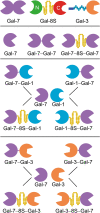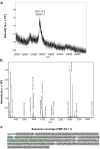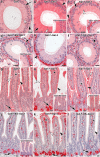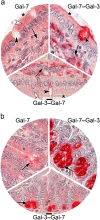Imitating evolution's tinkering by protein engineering reveals extension of human galectin-7 activity
- PMID: 34152508
- PMCID: PMC8460509
- DOI: 10.1007/s00418-021-02004-w
Imitating evolution's tinkering by protein engineering reveals extension of human galectin-7 activity
Abstract
Wild-type lectins have distinct types of modular design. As a step to explain the physiological importance of their special status, hypothesis-driven protein engineering is used to generate variants. Concerning adhesion/growth-regulatory galectins, non-covalently associated homodimers are commonly encountered in vertebrates. The homodimeric galectin-7 (Gal-7) is a multifunctional context-dependent modulator. Since the possibility of conversion from the homodimer to hybrids with other galectin domains, i.e. from Gal-1 and Gal-3, has recently been discovered, we designed Gal-7-based constructs, i.e. stable (covalently linked) homo- and heterodimers. They were produced and purified by affinity chromatography, and the sugar-binding activity of each lectin unit proven by calorimetry. Inspection of profiles of binding of labeled galectins to an array-like platform with various cell types, i.e. sections of murine epididymis and jejunum, and impact on neuroblastoma cell proliferation revealed no major difference between natural and artificial (stable) homodimers. When analyzing heterodimers, acquisition of altered properties was seen. Remarkably, binding properties and activity as effector can depend on the order of arrangement of lectin domains (from N- to C-termini) and on the linker length. After dissociation of the homodimer, the Gal-7 domain can build new functionally active hybrids with other partners. This study provides a clear direction for research on defining the full range of Gal-7 functionality and offers the perspective of testing applications for engineered heterodimers.
Keywords: Calorimetry; Glycosylation; Lectin; Proliferation; Protein design; p53.
© 2021. The Author(s).
Conflict of interest statement
The authors have no relevant financial or non-financial interests to disclose.
Figures








References
-
- Ahmad N, Gabius H-J, Kaltner H, André S, Kuwabara I, Liu F-T, Oscarson S, Norberg T, Brewer CF. Thermodynamic binding studies of cell surface carbohydrate epitopes to galectins-1, -3 and -7. Evidence for differential binding specificities. Can J Chem. 2002;80:1096–1104. doi: 10.1139/v02-162. - DOI
-
- Avrameas S. Emploi de la concanavaline-A pour l'isolement, la détection et la mesure des glycoprotéines et glucides extra- ou endo-cellulaires. C R Acad Sci (paris) 1970;18:2205–2208. - PubMed
MeSH terms
Substances
Grants and funding
LinkOut - more resources
Full Text Sources
Research Materials
Miscellaneous

